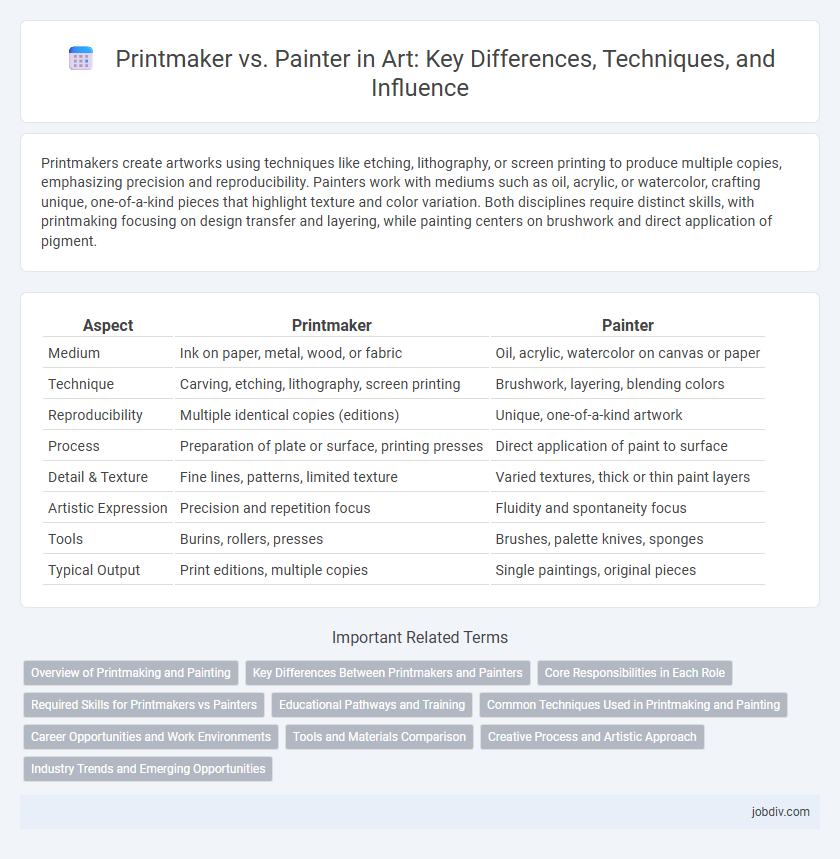Printmakers create artworks using techniques like etching, lithography, or screen printing to produce multiple copies, emphasizing precision and reproducibility. Painters work with mediums such as oil, acrylic, or watercolor, crafting unique, one-of-a-kind pieces that highlight texture and color variation. Both disciplines require distinct skills, with printmaking focusing on design transfer and layering, while painting centers on brushwork and direct application of pigment.
Table of Comparison
| Aspect | Printmaker | Painter |
|---|---|---|
| Medium | Ink on paper, metal, wood, or fabric | Oil, acrylic, watercolor on canvas or paper |
| Technique | Carving, etching, lithography, screen printing | Brushwork, layering, blending colors |
| Reproducibility | Multiple identical copies (editions) | Unique, one-of-a-kind artwork |
| Process | Preparation of plate or surface, printing presses | Direct application of paint to surface |
| Detail & Texture | Fine lines, patterns, limited texture | Varied textures, thick or thin paint layers |
| Artistic Expression | Precision and repetition focus | Fluidity and spontaneity focus |
| Tools | Burins, rollers, presses | Brushes, palette knives, sponges |
| Typical Output | Print editions, multiple copies | Single paintings, original pieces |
Overview of Printmaking and Painting
Printmaking involves creating artwork by transferring ink from a matrix onto a surface, often paper, using techniques like etching, lithography, or screen-printing, enabling multiple original copies of a single image. Painting is the application of pigments on surfaces such as canvas or wood, utilizing tools like brushes or knives to create unique, one-of-a-kind works characterized by texture and color blending. Both mediums offer distinct methods for artistic expression, with printmaking emphasizing reproducibility and precision, while painting highlights individual brushwork and spontaneity.
Key Differences Between Printmakers and Painters
Printmakers use techniques like etching, lithography, and screen printing to create multiple copies of an artwork, while painters apply pigments directly onto surfaces such as canvas or wood. Printmaking often involves working with plates or screens to transfer images, emphasizing reproducibility and consistency, whereas painting is characterized by unique, one-of-a-kind creations with emphasis on brushwork and texture. The mediums, tools, and processes distinctively shape the final aesthetic and artistic expression of printmakers versus painters.
Core Responsibilities in Each Role
Printmakers specialize in creating artworks through techniques like etching, lithography, and screen printing, emphasizing precision and reproducibility in their designs. Painters focus on applying pigments to surfaces such as canvas or walls, prioritizing color theory, brushwork, and composition to convey emotion and narrative. Both roles require a deep understanding of materials and artistic principles, but printmakers often engage more with mechanical processes while painters emphasize direct, tactile interaction with their medium.
Required Skills for Printmakers vs Painters
Printmakers require precision in technical processes such as etching, lithography, and screen printing, demanding expertise in handling inks, plates, and presses. Painters rely heavily on mastery of brushwork, color mixing, and composition to create texture and depth on canvas or other surfaces. Both disciplines necessitate strong visual design skills, but printmakers emphasize mechanical skills and reproducibility, whereas painters prioritize expressive, individual brushstrokes.
Educational Pathways and Training
Printmakers typically pursue specialized training in printmaking techniques through art schools, technical colleges, or university fine arts programs, emphasizing processes like etching, lithography, and screen printing. Painters often follow a broader fine arts education that covers various painting mediums and theories, frequently obtaining bachelor's or master's degrees in studio art. Both disciplines benefit from apprenticeships, workshops, and residencies, but printmakers require more technical expertise related to print production and materials.
Common Techniques Used in Printmaking and Painting
Printmakers commonly use techniques such as etching, lithography, screen printing, and woodcut, which involve transferring ink from a matrix onto paper or fabric to create multiples of one artwork. Painters typically employ methods like brushstroke application, glazing, impasto, and blending to directly manipulate pigments on surfaces like canvas or wood. Both disciplines demand mastery of composition, color theory, and texture but differ in their approach to reproducing or rendering images.
Career Opportunities and Work Environments
Printmakers often find career opportunities in specialized studios, art schools, and commercial printmaking firms, where collaborative environments support the production of editions and experimental techniques. Painters typically work in private studios or galleries, granting more individual creative control but requiring self-promotion to secure exhibitions and commissions. Both professions benefit from digital platforms for portfolio presentation, though printmakers may engage more with technical equipment and printing presses as part of their daily workflow.
Tools and Materials Comparison
Printmakers primarily use tools such as etching needles, brayers, and printing presses, working with materials like metal plates, woodblocks, and lithographic stones to create multiple impressions of an artwork. Painters rely on brushes, palette knives, and various applicators, utilizing pigments in oil, acrylic, or watercolor mediums on canvas, paper, or wood surfaces to produce singular, original pieces. The differing tools and materials influence the artistic process, texture, and final presentation unique to each discipline.
Creative Process and Artistic Approach
Printmakers employ a methodical creative process that involves preparing plates, blocks, or screens, emphasizing repetition and precision to produce multiple copies of an artwork. Painters engage in a more spontaneous and fluid artistic approach, applying pigments directly onto canvas or other surfaces to create unique, one-of-a-kind pieces with varied textures and brushwork. Both disciplines require mastery of materials and techniques but differ in their workflows, with printmaking balancing technical restraint and creativity, while painting prioritizes individual expression and immediacy.
Industry Trends and Emerging Opportunities
Printmakers are leveraging advancements in digital printing technology to create hybrid works that blend traditional techniques with modern innovation, attracting collectors seeking unique, reproducible art. Painters are increasingly exploring mixed media and incorporating augmented reality elements to enhance viewer engagement, expanding opportunities in gallery exhibitions and online platforms. Both artists benefit from the growing demand for limited-edition prints and immersive art experiences, driving new revenue streams in the evolving art market.
Printmaker vs Painter Infographic

 jobdiv.com
jobdiv.com